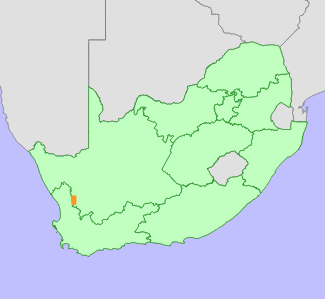|
Scientific Name | Aspalathus proboscidea R.Dahlgren |
Higher Classification | Dicotyledons |
Family | FABACEAE |
National Status |
Status and Criteria | Critically Endangered B1ab(ii,iii,v)+2ab(ii,iii,v) |
Assessment Date | 2009/02/19 |
Assessor(s) | D. Raimondo |
Justification | EOO and AOO <10 km², declining due to habitat loss to Rooibos tea cultivation at its only known location. |
Distribution |
Endemism | South African endemic |
Provincial distribution | Northern Cape |
Range | Bokkeveld Plateau. |
Habitat and Ecology |
Major system | Terrestrial |
Major habitats | Bokkeveld Sandstone Fynbos |
Description | Arid montane fynbos in sand, 700-800 m. |
Threats |
| Rooibos tea is a major threat as this species occurs in sand, the habitat ploughed up for Rooibos. Much of its habitat approximately nine kilometers west of Nieuwoudtville has been transformed by Rooibos tea cultivation in the past 10 years - this transformation is continuing. |
Population |
Population trend | Decreasing |
Assessment History |
Taxon assessed |
Status and Criteria |
Citation/Red List version | | Aspalathus proboscidea R.Dahlgren | CR B1ab(ii,iii,v)+2ab(ii,iii,v) | Raimondo et al. (2009) | | Aspalathus proboscidea R.Dahlgren | Insufficiently Known | Hilton-Taylor (1996) | |
Bibliography |
Dahlgren, R. 1988. Crotalarieae (Aspalathus). In: O.A. Leistner (ed). Flora of southern Africa 16 Fabaceae, Part 3 Papilionoideae, Fascicle 6:1-430. National Botanical Institute, Pretoria.
Goldblatt, P. and Manning, J.C. 2000. Cape Plants: A conspectus of the Cape Flora of South Africa. Strelitzia 9. National Botanical Institute, Cape Town.
Hilton-Taylor, C. 1996. Red data list of southern African plants. Strelitzia 4. South African National Botanical Institute, Pretoria.
Raimondo, D., von Staden, L., Foden, W., Victor, J.E., Helme, N.A., Turner, R.C., Kamundi, D.A. and Manyama, P.A. 2009. Red List of South African Plants. Strelitzia 25. South African National Biodiversity Institute, Pretoria.
|
Citation |
| Raimondo, D. 2009. Aspalathus proboscidea R.Dahlgren. National Assessment: Red List of South African Plants version 2024.1. Accessed on 2025/10/26 |
 Comment on this assessment
Comment on this assessment


